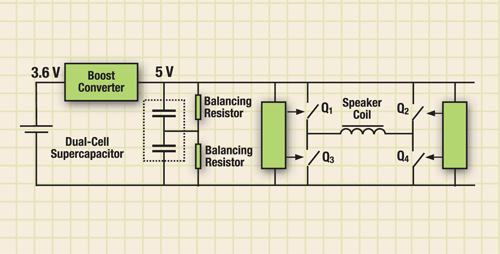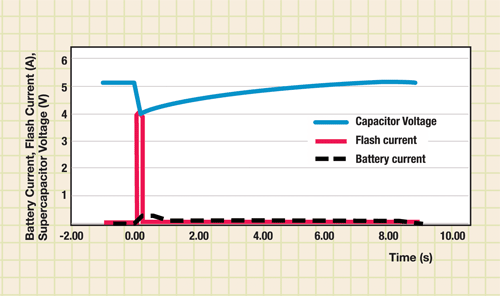Overcoming power-delivery limitations can boost flash and audio performance in portable devices
BY PIERRE MARS
CAP-XX
Sydney, Australia
http://www.cap-xx.com
As consumers become more dependent on their handheld devices, their demands for quality on every level of functionality will continue to increase. With music, consumers expect a distortion-free, iPod-quality experience. With flash photos, consumers want their cell phones to deliver digital-still-camera quality.
But typical designs are hampered by the battery’s inability to provide enough peak power to drive increasingly complex mobile applications. Designers can now add a single, thin supercapacitor to meet all the device’s peak-power needs without compromising slim handset design.
Supercapacitors can overcome the power-delivery constraints of batteries and energy-delivery limitations of conventional capacitors. They handle peak-power events—wireless transmission, GPS, audio, LED flash, video, and battery hot-swaps—then recharge from a battery at average power rate.
Audio quality problems
A typical cell-phone design features a standard 3.6-V battery powering two Class D amplifiers to drive a pair of 8-Ω speakers. This typical setup delivers a peak power of only 2.25 W. This lack of power can mean thin-sounding music with a weak bass beat.
Another problem arises when the battery becomes taxed from simultaneous peak-power demands to transmit in response to a network poll while the user is listening to music. The battery voltage drops, and the audio-amplifier supply voltage may drop enough to cause distortion, which the user hears as a “click.” Finally, a 1-A or greater peak-power demand on the battery will cause a ripple in the audio-amplifier supply voltage, which may create audio noise—a 217-Hz buzz—during a phone call.
LED flash challenges
Standard camera-phones struggle to generate enough flash power to produce clear pictures in low light. High-current LEDs need up to 400% more power than a battery can provide to achieve full light intensity. Clear pictures require sufficient light energy during image-capture time.
To calculate light energy, sum light power, or intensity of the flash (in lux) over duration of the flash exposure (in seconds):
Light Power (lux) x Flash Exposure Time (s) = Light Energy (lux-s)
Ten to 15 lux-s of light energy is said to be ideal for high-resolution pictures.
As an LED alternative, xenon flash tubes driven by electrolytic storage capacitors deliver excellent light power, but have a short flash exposure. And, the required electrolytic storage capacitors are bulky for slimline design, operate at high voltages, take longer to recharge between flashes, and cannot be used for other peak-power needs.

Fig. 1. A 0.55-F, 85-mΩ dual-cell supercapacitor delivers 5-W power-bursts to drive peak-power functions such as audio and LED flash. A battery covers the phone’s average audio power needs of 0.5 to 1 W, recharging the supercapacitor between bursts.
Mobile applications
In Fig. 1 , a 0.55-F 85-mΩ dual-cell supercapacitor delivers 5-W power-bursts to drive peak-power functions such as audio and LED flash. A battery covers the phone’s average audio power needs of 0.5 to 1 W, recharging the supercapacitor between bursts.
For example, if a 0.5-F supercapacitor discharges 1 V during a flash pulse, it only requires a 250-mA recharge current for 2 s. Figure 2 shows flash and battery current for a flash pulse driving a four-LED array at 1 A each.

Fig 2. The supercapacitor provides 4-A flash current while discharging from 5.2 to 4.0 V, and the battery provides 300-mA charge current to the supercapacitor.
In the case of audio, this leaves enough battery power to handle data transfers and network polls without compromising audio power. The supercapacitor powers the audio amplifier at 5 V—compared to 3.6 V directly from a battery — thereby doubling peak audio power for full-sounding music with a strong bass beat.
The supercapacitor also reduces noise by supplying peak power with less voltage droop than the battery would, and eliminates any 217-Hz buzz when a GSM/GPRS/EDGE phone transmits by protecting the audio amplifier from other peak loads the battery supplies such as the RF power amplifier. Because the supercapacitor supplies high peak currents, designers can use 4-Ω instead of standard 8-Ω speakers, further doubling peak audio power.
The company tested typical mobile-phone audio circuits, both with and without a supercapacitor. In tests one and two, two circuits were built, each with two Class D audio amplifiers: one powered by a battery alone to drive one pair of 8-Ω speakers, the other supported by a supercapacitor to drive two pairs of 8-Ω speakers.
Bass beat . A 100-Hz bass beat lasting 120 ms repeated every 0.5 s tested speaker power and battery current. The supercapacitor tripled peak audio power from 1.65 to 5.2 W.
Network poll. A 2-A, 1.15-ms power pulse simulated a GSM/GPRS/EDGE network poll response while the audio amplifier played a 1-kHz tone at maximum amplitude. The supercapacitor protected the audio amplifier from the battery voltage droop, eliminating distortion during wireless transmission.
Listening to music . Using two sets of SonyEricsson MPS60 external speakers and audio amplifiers, engineers modified one set with a supercapacitor charged to 5 V to power the audio amplifier, then connected a second pair of 8-Ω speakers to the original pair. Playing a piece of music to compare them, the supercapacitor-modified set of speakers more than doubled audio power from 2.24 to 4.96 W for the same peak battery power.
Audio conclusions
The supercapacitor:
Doubled or tripled peak speaker power, for no increase in peak battery current.
Lifted the audio amp power supply from ~3.6 V (battery voltage) to 5 V.
Stiffened the 5-V rail so the battery could service other peak loads a phone must supply.
The supercapacitor solution also delivered:
Fuller bass sound during the bass-beat test.
Distortion-free music during simultaneous peak-power demands.
Richer music on a supercapacitor-powered amplifier and speakers.
Camera-phone flash tests
The company tested three solutions for their ability to provide the light energy that camera phones of 2 MPs or more need to take DSC-quality pictures in low light:
Xenon: a SonyEricsson K750 with an external flash accessory and a K800 with two internal electrolytic capacitors.
Standard battery-powered LEDs: Nokia N73.
Supercapacitor-powered LEDs: The company retrofitted the Nokia N73 with a 0.55-F, 50-mΩ supercapacitor to drive a four-LED array at a high current of 1 A each. The supercapacitor delivers 15 W of pulse power to the LEDs, compared to a battery which can only deliver 1 to 2 W.
A photo detector measured on-axis illumination while a digital storage oscilloscope captured light power over time at 1 and 2 m from the source. The areas under the power curves were integrated to measure the light energy at the detector as a function of time.
LED flash conclusions
From 2 m away, the supercapacitor-powered four-LED-array was the only case that achieved a light energy above the recommended 10 lux-s (10.8) for high-resolution pictures.
The SonyEricsson K750 with its large external flash accessory performed the best of the xenon flashes with 9.5 lux-s. The standard LED flash unit in the Nokia N73 delivered only 0.43 lux-s.
Supercapacitors are slimmer (2 mm) than the xenon solution (i.e. the K800, including its electrolytic storage capacitor, occupies 3.8 cm3 ), use a lower voltage (5 V compared to a 330-V electrolytic storage capacitor), take only 2 s compared to 8 s in the K800 to recharge between flashes, and can offload other peak-power demands from the battery. ■
Advertisement
Learn more about CAP-XX





